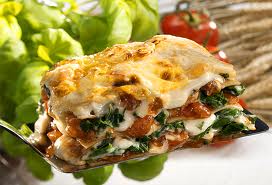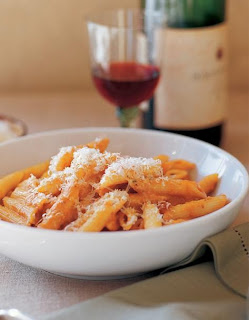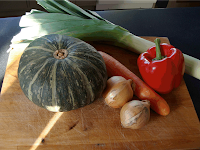Classic Italian
LASAGNA
 Lasagna is a dish that can be made ahead and can feed a crowd; it’s as easy to make for twelve as it is for four. I actually have lasagna parties where I make both the classic version and a fantastic vegetarian version, and my guests mix and match. If you make the lasagna ahead of time and serve it family style with a simple green salad as a side, you can feed a whole crowd while not spending more than five minutes in the kitchen during your party literally, only five minutes. It can take longer just to give directions to the pizza-delivery guy.
Lasagna is a dish that can be made ahead and can feed a crowd; it’s as easy to make for twelve as it is for four. I actually have lasagna parties where I make both the classic version and a fantastic vegetarian version, and my guests mix and match. If you make the lasagna ahead of time and serve it family style with a simple green salad as a side, you can feed a whole crowd while not spending more than five minutes in the kitchen during your party literally, only five minutes. It can take longer just to give directions to the pizza-delivery guy.6 MAIN-COURSE SERVINGS
Salt
2 tablespoons vegetable oil
15 dry lasagna noodles (about 12 ounces)
3 tablespoons extra-virgin olive oil
1 pound ground beef chuck
1 teaspoon freshly ground black pepper, plus more to taste
2½ cups Béchamel Sauce
1½ cups Marinara Sauce
1½ pounds whole-milk ricotta cheese
3 large eggs
2 tablespoons unsalted butter
2 (10-ounce) packages frozen chopped spinach, thawed and squeezed dry
3 cups shredded mozzarella cheese
¼ cup freshly grated Parmesan cheese
Bring a Large Pot of salted water to a boil. Add the vegetable oil (the oil will help prevent the lasagna noodles from sticking together). Cook the lasagna until almost al dente, about 6 minutes (the center of the pasta should remain somewhat hard so that it won’t overcook and become soggy when baked). Drain, then rinse the noodles under cold water to stop the cooking and help remove any excess starch. Cover lightly with a damp towel to prevent the pasta from drying out. Set aside.
In a large sauté pan, heat the olive oil over a medium-high flame. Add the ground beef and ½ teaspoon each of salt and pepper, and sauté until the beef is brown, breaking up any large clumps, about 8 minutes. Remove from the heat and drain any excess fat. Let cool completely.
Position the rack in the center of the oven and preheat the oven to 375 degrees F.
In a medium bowl, mix the béchamel and marinara sauces to blend. Season the sauce with more salt and pepper to taste.
In another medium bowl, mix the ricotta, eggs, and ½ teaspoon each of salt and pepper to blend. Set aside. Spread the butter over a 13x9-inch baking dish. Spoon one third of the béchamel-marinara sauce over the bottom of the dish. Arrange 5 lasagna noodles atop the sauce, overlapping slightly and covering the bottom of the dish completely. Spread the ricotta mixture evenly over the noodles. Top with the spinach. Arrange 5 more lasagna noodles atop the spinach, then top with the ground beef. Spoon one third of the remaining béchamel-marinara sauce over, then sprinkle with ½ cup of mozzarella cheese. Top with the remaining 5 sheets of lasagna noodles. Spoon the remaining béchamel-marinara sauce over the lasagna noodles, then sprinkle with the remaining mozzarella cheese and the Parmesan cheese. (The lasagna can be made up to this point 1 day ahead. Cover tightly with plastic wrap and refrigerate. Uncover before baking.)
Line a large, heavy baking sheet with foil. Place the baking dish on the baking sheet. Bake until the lasagna is heated through and the top is bubbling, about 45 minutes.
Individual Vegetarian
LASAGNAS
 The beauty of a baked pasta like this is that you can really use any vegetables you want, as long as you cut them all to the same size. This version uses a lot of them, because I like the variety in textures and flavors. But if you’re not a huge fan of any one of these vegetables, just omit it, and use the same quantity of another. If you prefer a simpler dish with fewer vegetables, you can do that too. It’s really up to you. You can also feel free to assemble one large lasagna in a 13x9-inch pan from these ingredients.
The beauty of a baked pasta like this is that you can really use any vegetables you want, as long as you cut them all to the same size. This version uses a lot of them, because I like the variety in textures and flavors. But if you’re not a huge fan of any one of these vegetables, just omit it, and use the same quantity of another. If you prefer a simpler dish with fewer vegetables, you can do that too. It’s really up to you. You can also feel free to assemble one large lasagna in a 13x9-inch pan from these ingredients.6 MAIN-COURSE SERVINGS
Salt
2 tablespoons vegetable oil
1 pound fresh lasagna sheets
3 tablespoons extra-virgin olive oil
1 medium onion, finely chopped
1 large carrot, peeled and finely chopped
1 large zucchini, finely chopped
1 large yellow summer squash, finely chopped
1 bunch of asparagus, steamed and cut into ¼-inch slices
¾ teaspoon freshly ground black pepper, plus more to taste
1½ cups Marinara Sauce, or 2 cups for a large lasagna
1 (16-ounce) can white beans, rinsed and drained
2 (10-ounce) packages frozen chopped spinach, thawed and squeezed dry
2 cups shredded mozzarella cheese
½ cup freshly grated Parmesan cheese
3 tablespoons unsalted butter, cut into pieces
Preheat The Oven to 375 degrees F. Bring a large pot of salted water to a boil. Add the vegetable oil, then the lasagna sheets, and cook until almost al dente, about 4 minutes. Drain and gently rinse the lasagna sheets under cold water to stop them from cooking and to help remove any excess starch. Cover lightly with a damp towel to prevent the pasta from drying out. Set aside.
In a large skillet, heat the olive oil over a medium flame. Add the onion and sauté until soft, about 5 minutes. Add the carrot and sauté for 3 minutes. Add the zucchini and summer squash and sauté for 5 minutes. Add the asparagus and sauté for 2 minutes. Season the vegetable mixture with ½ teaspoon each of salt and pepper. Remove from the heat and let cool.
Using a 6-inch-diameter cookie cutter, cut the cooled lasagna sheets into 18 circles. Coat the bottom of each of six 6-inch gratin dishes with 1 teaspoon of marinara sauce. Place 1 pasta circle over the bottom of each dish. In a medium bowl, toss the beans with ¼ teaspoon each of salt and pepper. Arrange the beans and then the spinach over the pasta circles in the dishes, dividing equally. Top each with another pasta circle, pressing gently to compact slightly. Spoon the sautéed vegetables over the lasagnas, dividing equally, then top each with 1 tablespoon of marinara sauce. Place a third pasta circle atop each and spread each with 1 tablespoon of marinara sauce. Sprinkle with the mozzarella and Parmesan cheese, and dot with the butter. Line a baking sheet with foil and place the dishes on the prepared baking sheet. (The lasagnas can be made up to this
point 1 day ahead. Cover tightly with plastic wrap and refrigerate. Remove the plastic wrap before baking.)
Bake the lasagnas until brown on top and the sauce bubbles, about 20 minutes.





























